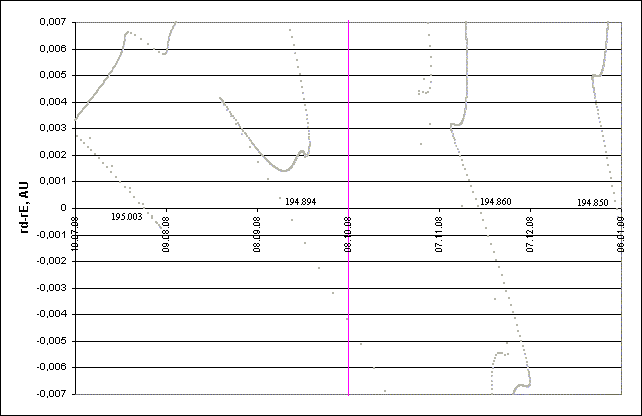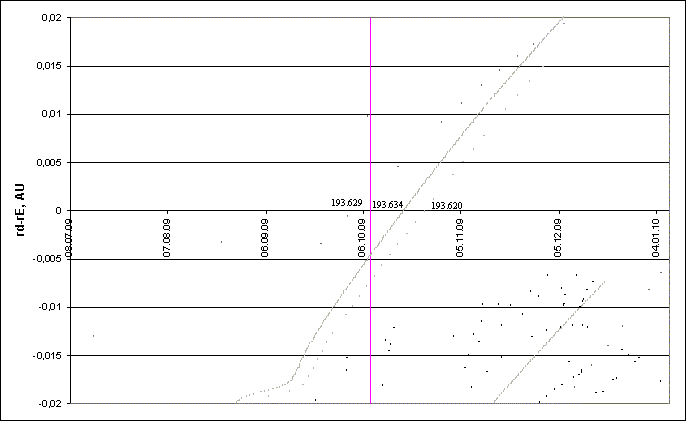Draconids 2008: prediction of activity
to the list of predictions
Introduction
Computation characteristics
We'd like to introduce the results of Draconid meteor stream simulation aimed to the prediction of shower activity in 2008. The simulation was made for the trails of latest 28 revolutions, i.e, from the 1817 trail. The Author used the program by S. Shanov and S. Dubrovsky "Comet's Dust 2.0" to calculate orbital elements of ejected meteor particles. To estimate expected ZHRs for different encounters the model by E. Lyytinen and T. van Flandern given in their paper [4] was used with some Author's alterations made in order to adopt the model for ejection velocity (Vej) instead of da0 (difference in a-semimajor axis) and to convert the model from the Leonid stream (for which it was originally created) to the Draconids. The computation considered only gravitational forces. The prediction includes all encounters found within interval +/-0.007 a.u. The following parts of trails were computed: the first 15 rev. trails for ejection velocities [-50;100] m/s, 16-28 rev. trails - [-30;50] m/s.
Results
Introduction
Computation characteristics
We'd like to introduce the results of Draconid meteor stream simulation aimed to the prediction of shower activity in 2008. The simulation was made for the trails of latest 28 revolutions, i.e, from the 1817 trail. The Author used the program by S. Shanov and S. Dubrovsky "Comet's Dust 2.0" to calculate orbital elements of ejected meteor particles. To estimate expected ZHRs for different encounters the model by E. Lyytinen and T. van Flandern given in their paper [4] was used with some Author's alterations made in order to adopt the model for ejection velocity (Vej) instead of da0 (difference in a-semimajor axis) and to convert the model from the Leonid stream (for which it was originally created) to the Draconids. The computation considered only gravitational forces. The prediction includes all encounters found within interval +/-0.007 a.u. The following parts of trails were computed: the first 15 rev. trails for ejection velocities [-50;100] m/s, 16-28 rev. trails - [-30;50] m/s.
Results

Fig. 1. Space-temporal projection of Draconids trails parts onto their minimal distance passages dirung the period 08.07.2008-08.01.2010 (correspondence between colours of the particles and their ejection velocities can be seen here).

Fig. 2. Detailed space-temporal projection of Draconids trails parts onto their minimal distance passages dirung the period 10.07.2008-06.01.2009 (correspondence between colours of the particles and their ejection velocities can be seen here).

Fig. 3. Detailed space-temporal projection of Draconids trails parts onto their minimal distance passages dirung the period 10.07.2009-06.01.2010 (correspondence between colours of the particles and their ejection velocities can be seen here).
Draconids in 2008
As shown on the Fig. 2, in 2008 around Draconid maximum time there are only scattered fragments of stream trails near the Earth's orbit. They consist of particles with high ejection velocities. No one of these fragments come close enough to the Earth, so we do not expect Draconid activity this year.
Draconids in 2008 (overview)
On the Fig. 3 we can see that in 2009 two trails intersect the Earth's orbit quite close to the maximum time of the shower. They do it on solar longitudes 193.629° and 193.634°. These are 1831 and 1913 trails. Due to low density of them, especially of 1831 trail, as well as high negative ejection velocities of particles in the trails activity is very unlikely. Nevertheless, if anything appears from these trails, maximum of 1831 trail is expected on 06.10.2009 at 21:43 UT (Radiant: RA=262.3, Dec=+54.9, Vg=20.5), of 1913 trail - on 06.10.2009 at 21:50 UT (Radiant: RA=262.3, Dec=+53.6, Vg=20.1).
References
1. "Comet's dust 2.0" program by S. Shanov and S. Dubrovsky. [Used for orbital computations.]
2. Information from Gary W. Kronk's page http://www.maa.agleia.de
4. Lyytinen E, van Flandern T. "Predicting the strength of Leonid outbursts", 2000, Icarus, P. 158-160.